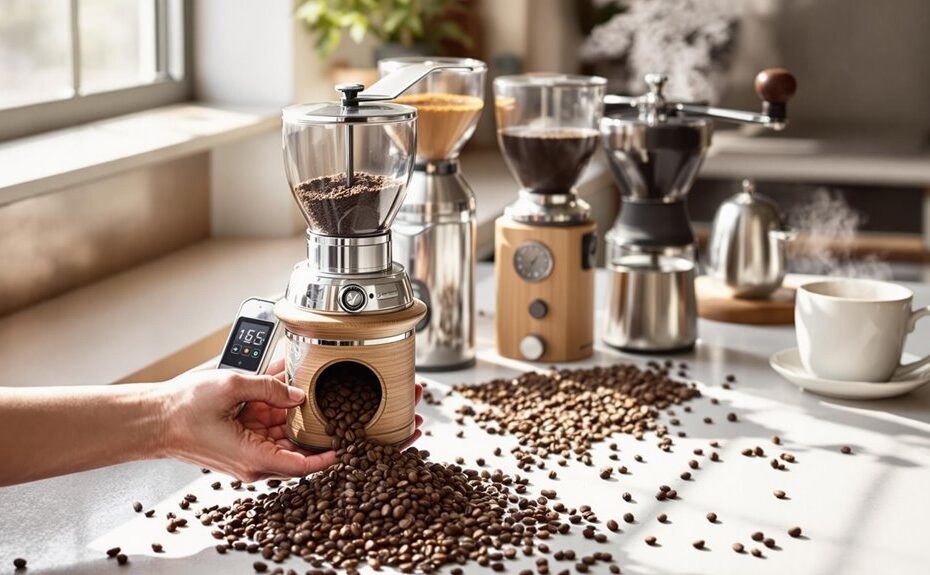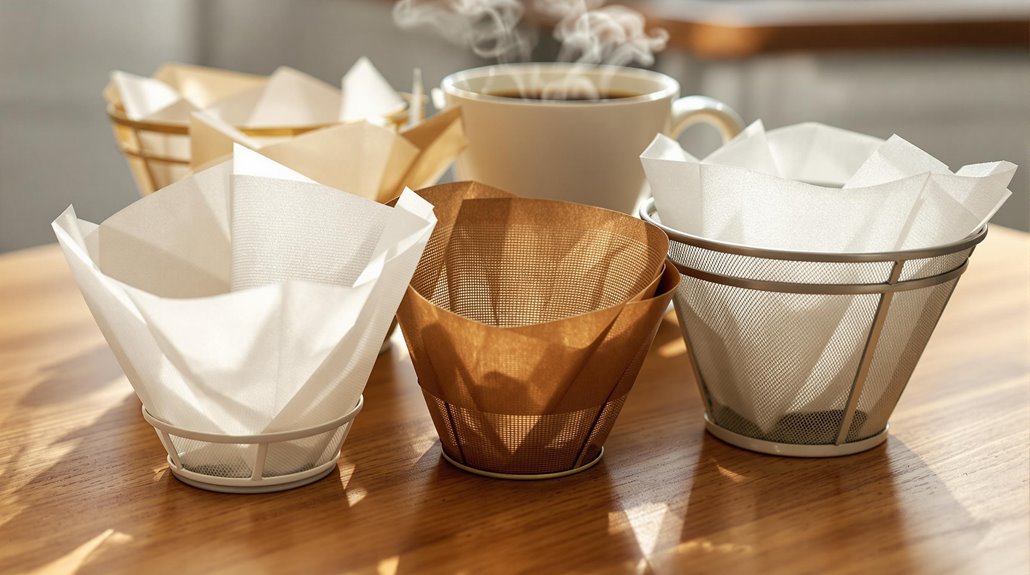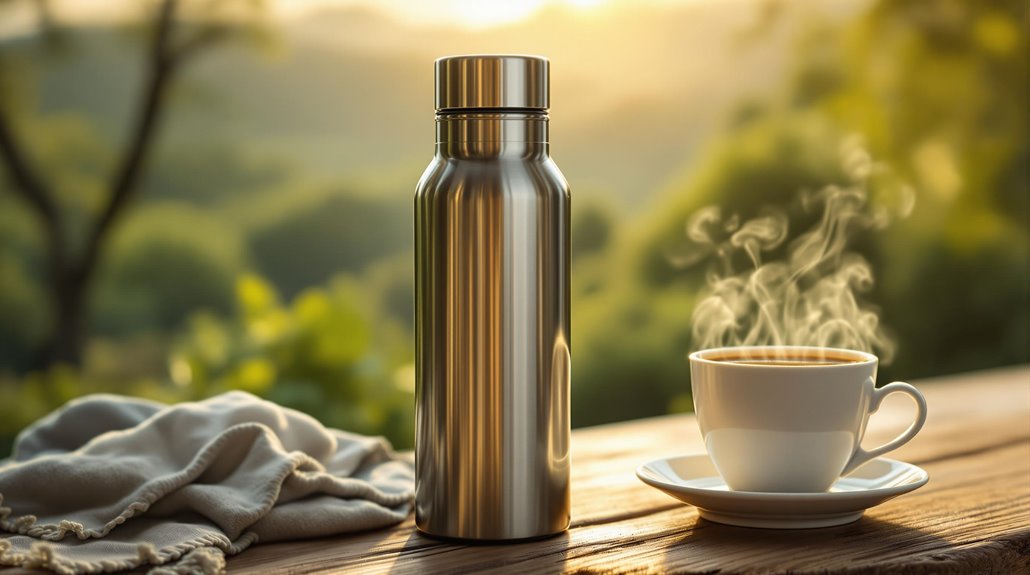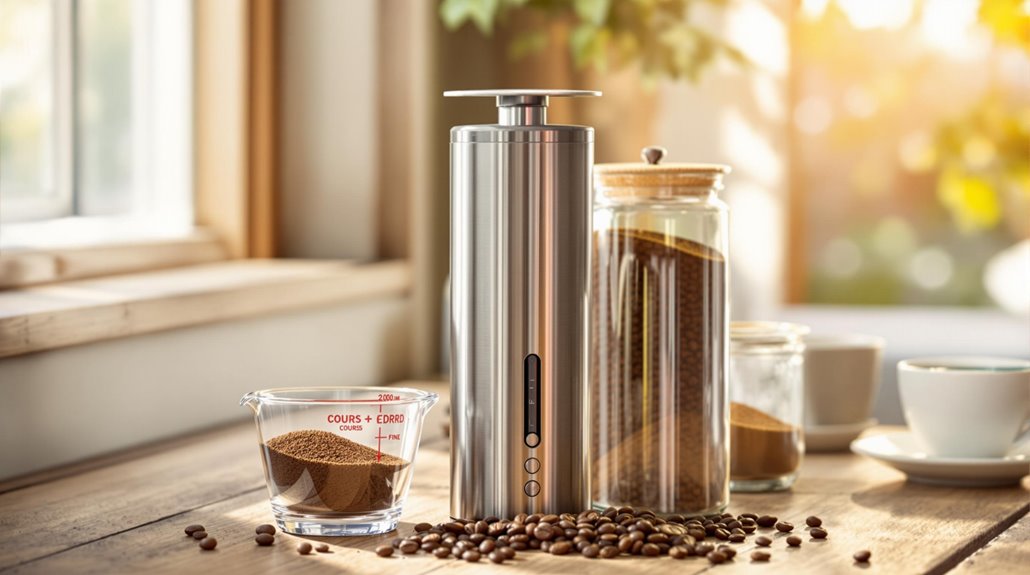







You might not realize that the grind size of your coffee can greatly influence the flavor and aroma of your brew. Selecting the appropriate coffee grinder isn't just about convenience; it's essential for releasing the full potential of your beans, depending on your brewing method. With various types of grinders available, each offering unique features and benefits, knowing what to prioritize can be overwhelming. So, how do you determine which grinder aligns best with your coffee preferences and lifestyle?
Key Takeaways
- Determine your brewing method (espresso, pour-over, French press) to select a grinder that offers the appropriate grind size adjustments.
- Choose between manual grinders for portability and precision or electric grinders for speed and convenience.
- Opt for a burr grinder over a blade grinder for consistent grind sizes essential for optimal extraction and flavor.
- Consider features like grind size adjustability (stepless vs. stepped) and burr type (flat vs. conical) for tailored grind quality.
- Invest in a high-quality grinder like the Baratza Encore or Fellow Opus to ensure long-term satisfaction and consistent performance.
Importance of Freshly Ground Coffee
When it comes to brewing the perfect cup of coffee, many enthusiasts agree that freshness is key. Freshly ground coffee retains essential aromatic compounds, with studies showing that up to 60% of volatile aromatics can dissipate just 15 minutes after grinding. By grinding coffee immediately before brewing, you guarantee that the flavor of your coffee is at its peak, preserving complexity and richness. Pre-ground coffee oxidizes quickly, leading to stale flavors, while freshly ground beans can maintain ideal flavor for up to two weeks when stored properly.
Moreover, the grinding process allows for precise adjustments to grind size, critical for various brewing methods like espresso, pour-over, or French press. Each method requires a consistent grind size to achieve ideal extraction; otherwise, you'll end up with uneven flavor profiles. By controlling the grind size, you enhance the overall coffee experience, allowing the unique characteristics of your chosen coffee beans to shine. In fact, freshly ground coffee can enhance flavor complexity by up to 30% compared to pre-ground options. So, investing in a quality grinder is essential for anyone serious about their coffee.
Types of Coffee Grinders
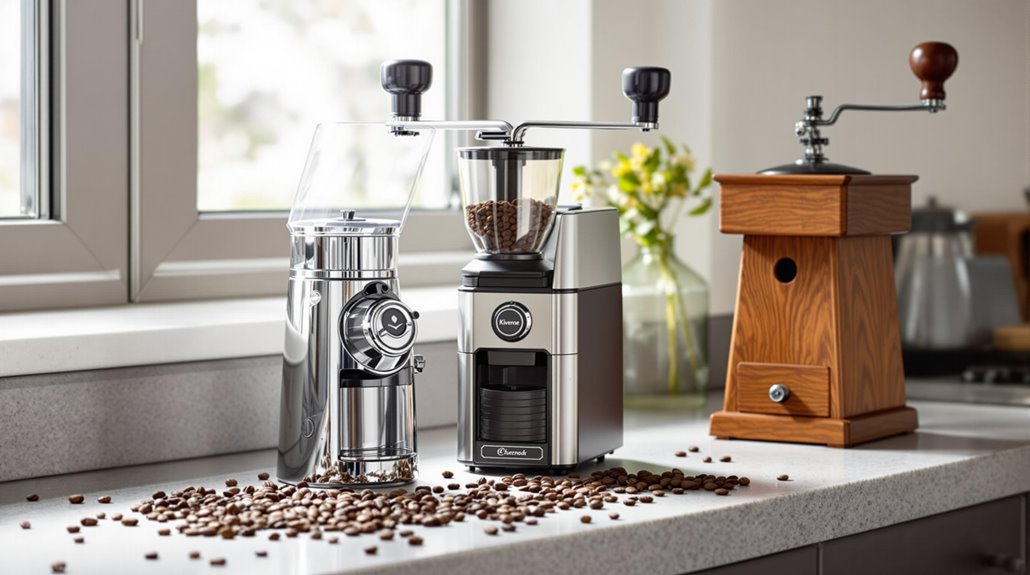
Understanding the various types of coffee grinders is essential for anyone looking to elevate their brewing experience. The two main categories are blade grinders and burr grinders. Blade grinders use spinning blades to chop coffee beans, which leads to inconsistent grind sizes. They're typically more affordable, making them a popular choice for beginners. However, if you're aiming for precision, burr grinders are the way to go.
Burr grinders crush beans between two burrs, offering a consistent grind size that's perfect for espresso and specialty brewing methods. Within burr grinders, you'll find flat burr and conical burr types. Flat burr grinders utilize parallel burrs for even particle sizes but may generate more heat and noise. On the other hand, conical burr grinders feature angled burrs that allow for finer adjustments, producing sweeter flavors while requiring less torque during operation.
You also have the option of manual grinders and electric burr grinders. Manual grinders are portable and quiet but require some physical effort. Electric grinders provide speed and convenience but tend to be bulkier and noisier. Your choice will depend on your brewing needs and lifestyle preferences.
Key Features to Consider
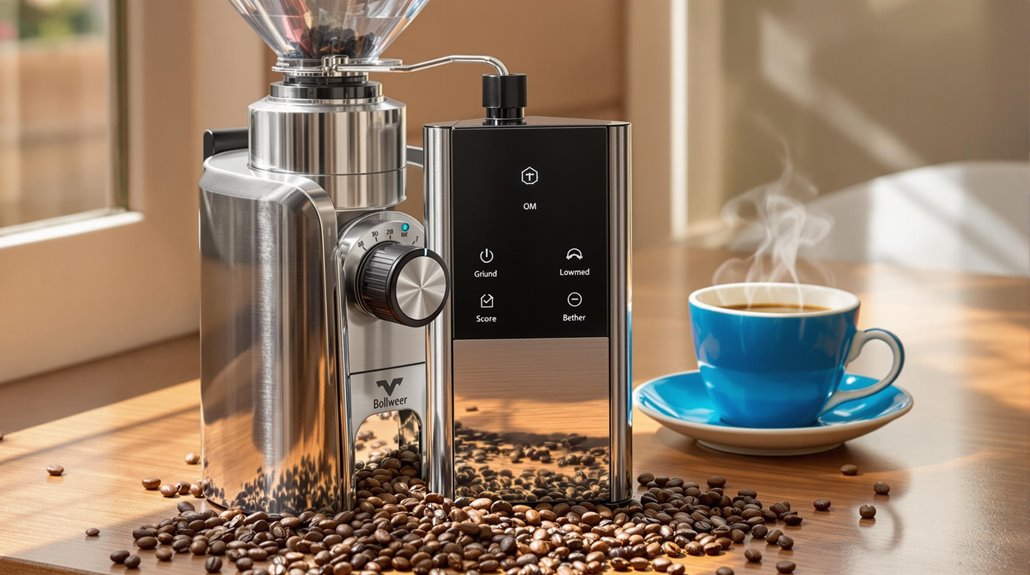
Several key features can substantially impact your coffee grinding experience and the quality of your brew. First and foremost, grind consistency is essential; burr grinders excel here, producing uniform grind sizes necessary for balanced extraction, while blade grinders fall short, leading to uneven particles that affect flavor.
Next, consider grind size adjustability. Stepless grinders allow infinite adjustments, perfect for fine-tuning espresso, while stepped grinders offer preset settings, making them suitable for simpler brewing methods like drip or French press.
The burr type and material also play a pivotal role. Conical burrs, whether steel or ceramic, are durable and yield sweeter flavors, whereas flat burrs provide consistency but may generate more heat and noise during operation.
Motor power and build quality shouldn't be overlooked. Grinders with higher wattage motors (100-400+ watts) support longer duty cycles, and those with more metal components tend to be more durable. Finally, additional features like programmable settings for timed dosing or grind size memory enhance convenience and guarantee consistent results, making your coffee experience even better.
Grinding Methods and Their Impact
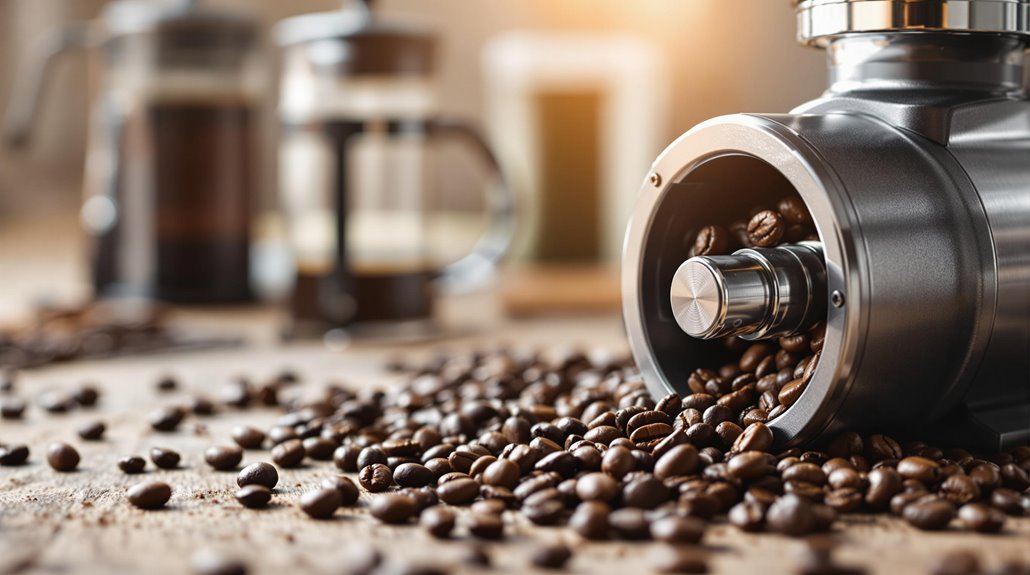
Grinding methods play a pivotal role in determining the flavor profile and overall quality of your coffee. When you use blade grinders, the spinning blades chop beans, often resulting in uneven grind sizes. This inconsistency can lead to poor extraction, making blade grinders less suitable for precise brewing methods like espresso. On the other hand, burr grinders crush beans between two burrs, providing consistent grind sizes essential for methods that require a fine or uniform grind, such as pour-over or French press.
Within burr grinders, you'll find flat burr grinders and conical burrs. While flat burr grinders offer consistent particle size, they can generate more heat and noise, potentially affecting flavor. Conical burrs, however, tend to produce sweeter flavors with less heat transfer, making them a preferred choice for many coffee enthusiasts.
Manual grinders require more effort but provide portability and quiet operation, which is ideal for travel or noise-sensitive settings, though they may yield less consistent grinds. Conversely, electric grinders deliver faster, more consistent grinding with adjustable settings, perfect for busy routines or brewing methods that demand precision and repeatability. Choosing the right grinding method is essential for achieving your desired coffee experience.
Entry-Level Grinder Recommendations
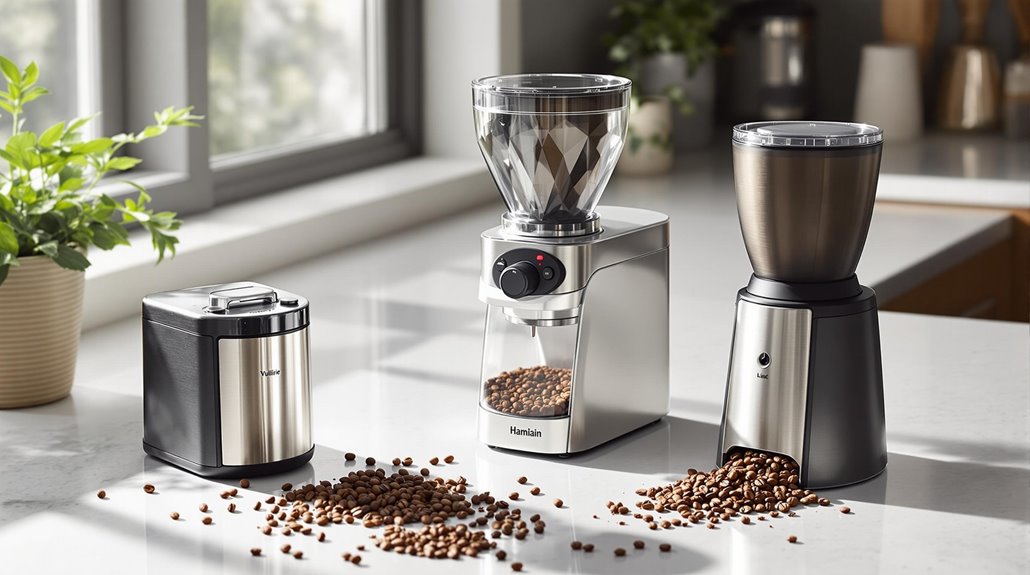
When you're starting your coffee journey, finding a grinder that balances affordability with versatility is key. Options like the Timemore C3 offer a budget-friendly choice, while models like the Baratza Encore and Fellow Opus provide exceptional grind quality for various brewing methods. Evaluating these entry-level grinders can help you secure great flavor without breaking the bank.
Budget-Friendly Options
Finding the right coffee grinder can substantially enhance your brewing experience without breaking the bank. If you're looking for budget-friendly options, there are several entry-level grinders that offer excellent performance at a reasonable price point. The Baratza Encore, priced at $159, is a durable, intuitive grinder perfect for drip, pour-over, and French press methods, making it a solid investment.
For those seeking affordability in a portable design, consider the Timemore C3 hand grinder, which starts at just $79. This model is compact and ideal for beginners or anyone short on space. If you prefer a manual option, the Hario Skerton is another affordable hand grinder that improves taste over blade grinders, though it requires more effort on your part.
While the Fellow Opus at $195 and the premium 1ZPresso K-Max at around $230 are exceptional regarding grind quality and versatility, they may stretch your budget. By focusing on the Baratza Encore, Timemore C3, and Hario Skerton, you can find quality grinders that enhance your coffee experience without overwhelming your wallet.
Versatile Brewing Capabilities
Choosing the right entry-level grinder can substantially impact your coffee brewing versatility, especially if you're looking to experiment with different methods. A grinder with a wide range of grind settings allows you to tailor the grind size to various brewing methods, from espresso to French press.
The Baratza Encore ($159) stands out for its consistent grind quality, making it ideal for drip, pour-over, and French press. If you're eyeing espresso capabilities, the Fellow Opus ($195) excels with its ability to deliver consistent grinds for both espresso and brewed coffee. For pour-over enthusiasts, the Fellow Ode Gen 2 ($350+) features 64mm flat burrs that guarantee fast, precise grinds.
If you prefer a manual option, the 1ZPresso K-Max Hand Grinder ($230) is versatile enough to grind coffee for multiple brew methods, including cold brew. On a tighter budget, the Timemore C3 Hand Grinder ($79) offers portability, though it may lack the grind consistency of its pricier counterparts. Ultimately, your choice should reflect the brewing methods you wish to explore and your need for grind quality and versatility.
Common Grinder Mistakes
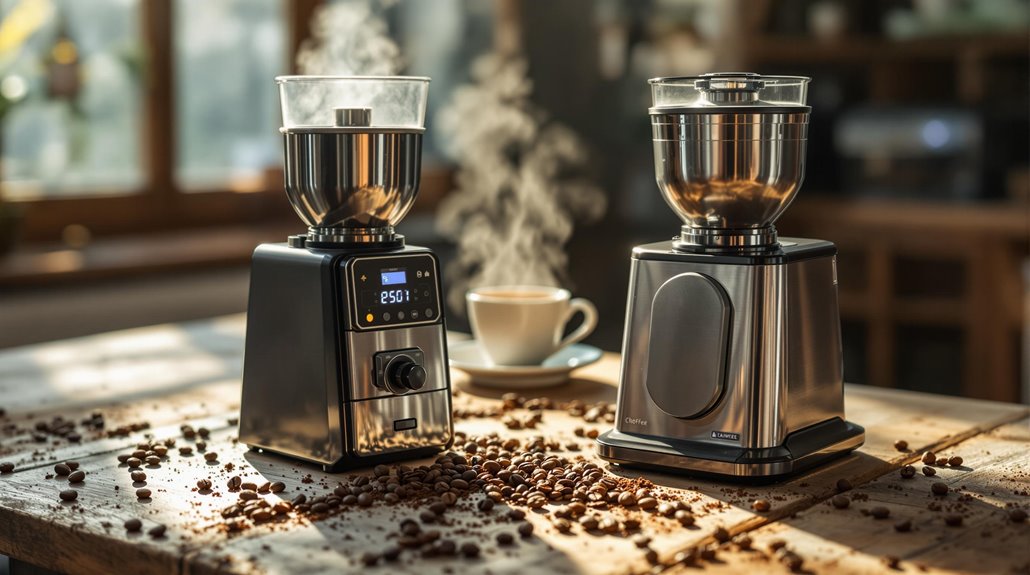
Over time, many coffee enthusiasts make common mistakes that hinder their brewing experience, particularly when it comes to selecting the right grinder. One prevalent issue is using cheap blade grinders, which often produce an inconsistent grind. This inconsistency can lead to bitter or sludgy coffee due to uneven extraction. Instead of purchasing multiple low-quality grinders, invest in a high-quality model upfront; it's more economical in the long run.
Another mistake is opting for pre-ground coffee as a permanent solution. While it's a better short-term choice than a suboptimal grinder, grinding your beans just before brewing is essential for peak flavor. If you choose a hand grinder like the Hario Skerton, be prepared for considerable effort, which might not appeal to those seeking convenience.
Don't overlook the importance of researching grinder features, such as burr type—flat vs. conical—and adjustability—stepped vs. stepless. These factors greatly impact your ability to achieve the ideal grind sizes for your brewing method, whether you need coarse for French press or fine for espresso. Being aware of these common mistakes can elevate your coffee experience immensely.
High-End Grinder Options
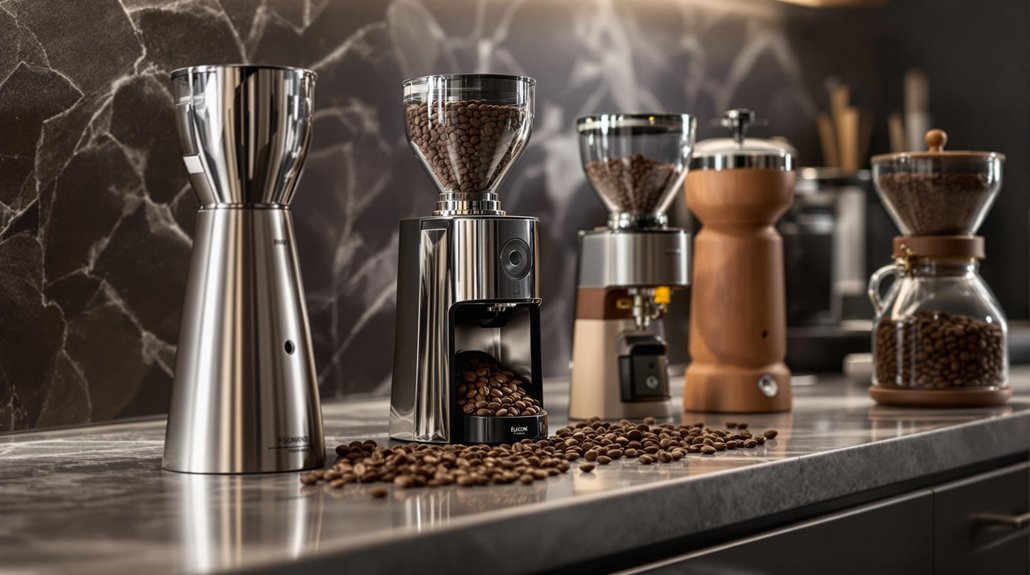
Investing in a high-end coffee grinder can dramatically enhance your brewing experience, delivering consistent grind quality and revealing the full flavor potential of your beans. High-end grinders like the Baratza Vario and Eureka Specialita are designed with precision in mind, making them ideal for both espresso and specialty coffee brewing.
The Baratza Vario features 54mm ceramic burrs and an impressive 230 grind settings, allowing you to fine-tune your grind for various brewing methods. Its flat burr design guarantees even particle size, critical for peak extraction. Meanwhile, the Eureka Specialita is known for its stepless adjustment and quiet operation, catering to home baristas who appreciate a seamless grinding experience.
When considering a high-end grinder, look for advanced features like programmable dosing and durable materials, such as stainless steel or ceramic burrs. These elements contribute to long-lasting performance and consistent grind quality. For those who favor pour-over or drip brewing, the Fellow Ode Gen 2 offers a sleek design and upgradeable burrs, starting at around $350. Choosing the right high-end grinder can greatly elevate your coffee journey, guaranteeing every cup is crafted to perfection.
Manual vs. Electric Grinders
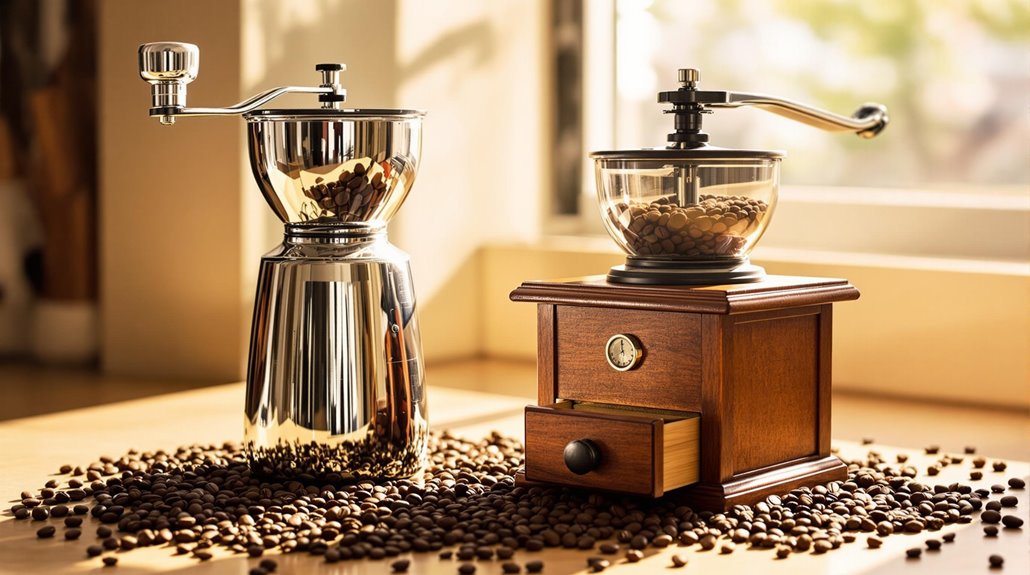
When comparing manual and electric grinders, you'll notice significant differences in grinding efficiency and convenience. Manual grinders are compact and portable, making them perfect for travel, but they demand more effort and may yield inconsistent grind sizes. In contrast, electric grinders offer speed and precision for larger quantities, though their bulkiness and noise can be drawbacks in certain settings.
Grinding Efficiency Comparison
Grinding efficiency plays a pivotal role in your coffee brewing experience, and understanding the differences between manual and electric grinders can help you make an informed choice. Electric grinders excel in speed, grinding coffee beans in under 30 seconds, while manual grinders might take 1-3 minutes, depending on the grind size and quantity. For instance, a manual grinder often requires 100-200 rotations to grind just 20 grams of coffee, whereas electric grinders accomplish this with minimal effort.
When it comes to consistency, electric grinders, particularly high-quality burr grinders, deliver precise grind sizes thanks to their motorized mechanics. In contrast, manual grinders can exhibit slight variations based on your technique, which may impact the flavor extraction of your ground coffee. High-end manual grinders, like the 1ZPresso K-Max, can achieve competitive grind speeds, processing 20 grams in just 30-40 seconds.
While electric grinders are ideal for large batches, manual grinders shine in small-scale grinding needs. Ultimately, your choice will depend on how you prioritize efficiency versus the tactile experience of grinding your beans.
Portability and Convenience Factors
Choosing between manual and electric coffee grinders often boils down to portability and convenience, key factors that can substantially affect your coffee routine. If you value portability, manual grinders shine with their compact and lightweight design, making them ideal for travel or outdoor use. They offer a quiet operation, allowing you to grind your beans in noise-sensitive environments without disturbing anyone.
On the other hand, electric grinders provide unmatched convenience and speed, perfect for busy mornings. However, they tend to be bulkier and require an electrical outlet, which can limit their portability. While electric grinders can deliver consistent grind sizes with minimal effort, manual grinders may require more physical effort, leading to potential inconsistencies.
If you're brewing larger quantities, electric grinders often come equipped with larger hoppers and advanced settings like timers, enhancing their convenience for daily use. Still, if you're on a budget and prefer a noise-free option, manual grinders can be a great fit. Ultimately, your choice will hinge on whether you prioritize portability and quiet operation or convenience and speed in your coffee-making routine.
Maintenance and Care Tips
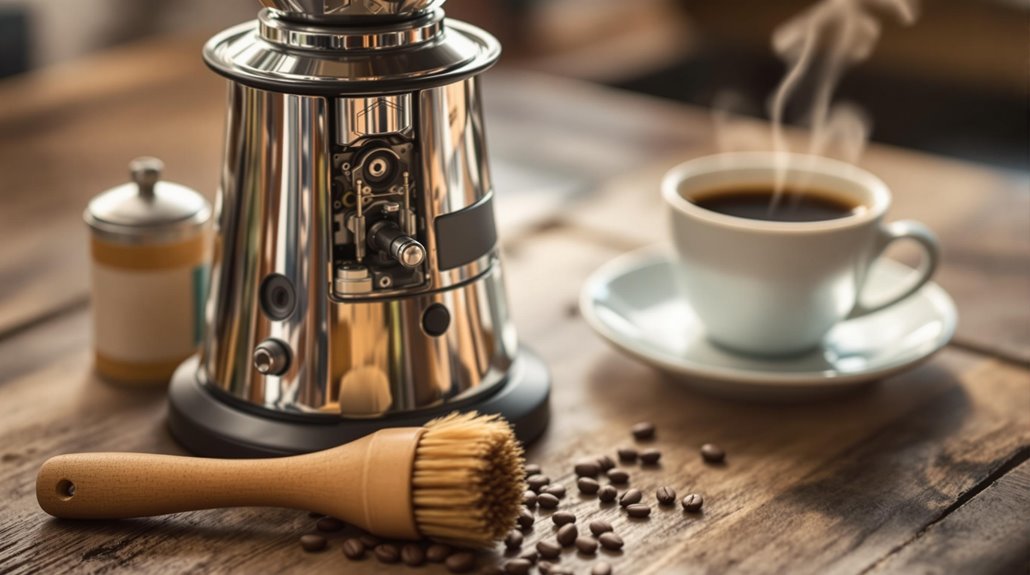
Keeping your coffee grinder in top shape is essential for achieving the best flavor from your beans. Regular maintenance guarantees that your grinder delivers a consistent grind quality, which is crucial for peak coffee extraction. Start by cleaning your grinder's burrs and hopper weekly with a soft brush to remove coffee oils and residue. This simple task helps maintain the integrity of your grind and keeps flavors vibrant.
For a deeper clean, disassemble your grinder monthly. Use soap and water for the hopper and a grinder cleaning tablet for the burrs, avoiding water or harsh chemicals directly on the burrs to prevent rust or damage. Additionally, check for wear on the burrs every 6-12 months. Dull burrs can lead to inconsistent grind sizes, negatively impacting your coffee quality.
Finally, store your grinder in a dry, cool place to prevent moisture buildup, which can affect both grind consistency and flavor. By following these maintenance tips, you'll prolong the life of your grinder and guarantee that each cup of coffee you make is as delicious as possible.
Final Thoughts on Grinder Selection
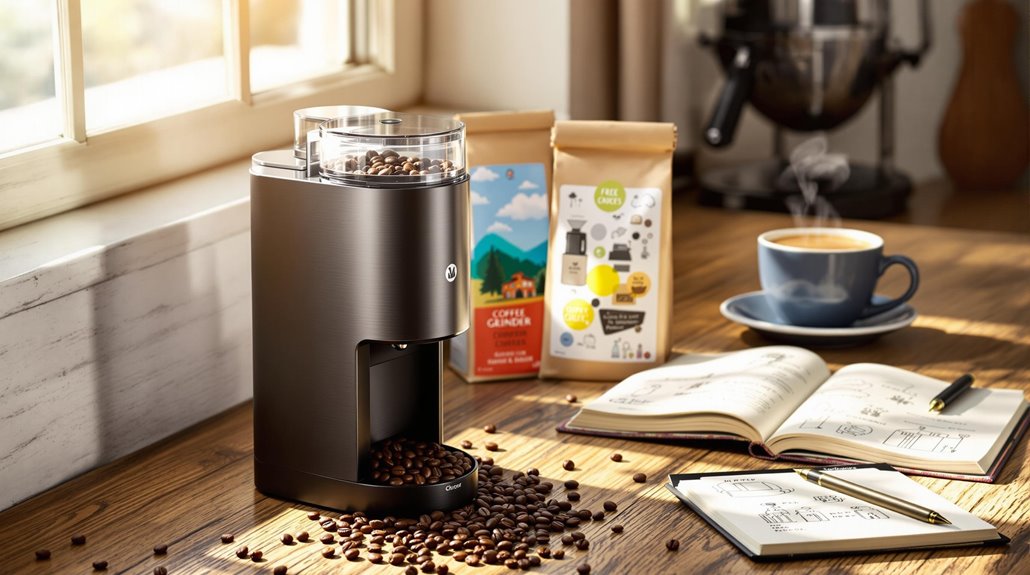
Selecting the right coffee grinder can notably improve your overall brewing experience. First, consider your preferred brewing methods, whether it's drip, pour-over, French press, or espresso, as each requires specific grind sizes for peak flavor extraction. Evaluate your budget carefully; investing in a high-quality burr grinder, like the Baratza Encore or Fellow Opus, can greatly enhance grind quality and guarantee long-term satisfaction.
Next, decide between manual and electric grinders. Manual grinders, such as the 1ZPresso K-Max, offer precision and portability, while electric models like the Fellow Ode Gen 2 provide convenience and speed. Pay special attention to grind size adjustability; stepless grinders, like the Eureka Specialita, afford finer control ideal for espresso, whereas stepped grinders are generally easier for various brewing methods.
Finally, don't overlook maintenance and durability. Choose grinders with easy-to-clean designs and robust materials, such as stainless steel or ceramic burrs, to guarantee longevity. By weighing these factors, you'll find a grinder that aligns with your needs, elevating your coffee experience to new heights.
Disclosure: As an Amazon Associate, I earn from qualifying purchases.
